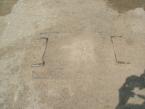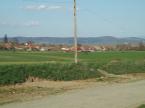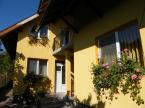Information
WIKI REFRESH Timiºoara (pronunciation in Romanian: [[Media:Timisoara.ogg|]]; Hungarian: Temesvár, German: Temeschburg, Temeschwar, or Temeswar, Serbian: Temi¹var or Темишвар, Banat Bulgarian: Timi¹vár) is a city in the Banat region of western Romania. With a population of 336,089 in 2006<ref> Adetim - Timiº County data base</ref>, it is the capital city of Timiº County. It is frequently spelled in English simply as Timisoara.
Name
All of the variants of its name derive from the Timiº River, known in Roman Antiquity as river Tibisis or Tibiscus. The evolution of the river name from antiquity (with the phonetic change "b" → "m") can be explained by the transition of Latin into Old Romanian.
Overview
Timiºoara is with 336,089 inhabitants one of the largest cities in Romania. It is a large economic as well as cultural center in Banat in the west of the country.It is a multicultural city with influential minorities, primarily Hungarians, Germans, and Serbs, as well as Italians, Bulgarians, and Greeks. It was the birthplace of Johnny Weissmuller (an Olympic swimmer, best known for his role as Tarzan).
The city is also called "Little Vienna", because it belonged for a very long time to the Habsburg Empire and the entire city center consists of buildings built in the Kaiser era, which reminds one much of the old Vienna. Timiºoara is an important university city with the emphasis on subjects like medicine, mechanics and electro-technology. An industrial city with extensive services, it was the first European city to be lit by electric street lamps in 1884. It was also the second European and the first city in what is now Romania with horse drawn trams in 1867. There are numerous claims that Gustave Eiffel, the creator of the Eiffel Tower in Paris, built one of Timiºoara's footbridges over the Bega.
The old city consists of historic city quarters with several historic squares and proms. These are:
- Cetate (Belváros in Hungarian, Innere-Stadt in German)
- Iosefin (Józsefváros, Josephstadt)
- Elisabetin (Erzsébetváros, Elisabethstadt)
- Fabric (Gyárváros, Fabrikstadt)
History
In the Roman period, there was a military camp named Zambara or Zurobara in the place where Timiºoara is today or in the immediate vicinity.<ref> Urban wood and modern life- the example of Timisoara City by Gheorghe Florian Borlea, Radu Brad, and Oliver Merce - Forest Research & Management Institute- ICAS Timisoara, RO</ref> During the time of the invasions of the nomad tribes of the Central-Asian plains, especially that of the Avars, on the site of the ruins of Zambara, a new settlement was built – Beguey.In 1019 Timiºoara (as Dibiscos/ Bisiskos/ Tibiskos/ Tibiskon/ Timbisko/etc.) was mentioned for the first time in written documents by the Byzantine Emperor Basil II, although not all historians agree with this identification.
In 1154 the Arabian geographer Sarif al Idrisi mentions the city saying it's a "nice city offering a lot of riches".
The first mention of the fort of Timiºoara (Castrum Temesiensis) is found in the decree of King Andrew II of Hungary dating from 1212.
Timiºoara was first mentioned in official documents as a city in 1474. It was captured by the Ottomans in 1552 and remained under Ottoman control until it was captured by Habsburg officer Prince Eugene of Savoy in 1716.
The demographic conditions of the region changed dramatically during the 167 year of Ottoman rule. In 1582 the city of Temeswar in spite of the bloody siege still had a Hungarian majority (the chief judge was István Herczegh - Preyer, Johann N.: Monographie der konigliche n Freistadt Temesvar - 1853). Later, the largest ethnic group in the city were Muslim Turks, and other smaller groups included Serbs, Jews, and Gypsies. <ref name="popo">Dr. Du¹an J. Popoviæ, Srbi u Vojvodini, knjige 1-3, Novi Sad, 1990 </ref>
After the city was captured by the Habsburg Empire, the Turkish population fled and we know about 600-700 inhabitants out of which 446 were Serbs, 144 Jewish, and 35 Armenians. <ref>According to captain Graf Paolo Wallis - Neumann, Victor: Istoria evreilor din Banat. Buc. 1999 </ref>
According to the 1720 data, the largest ethnic group in the city were Serbs, and other smaller groups were Romanians and Jews; there were no Hungarians and Germans in the city at that time. <ref name="popo"/> Later, many Germans settled in the city, and they became the largest ethnic group.
The "Armenische Stadt" as a separate quarter existed until the great plague of 1738.
In 1718 the first beer factory in Transylvania was built. The first tobacco mill in today's Romania was set up in Timiºoara. Between 1728 and 1771 a canal Bega was built to unite the city with the Danube river. In 1849 Timiºoara was named the capital of the Austrian crownland of Voivodship of Serbia and Tami¹ Banat as the result of the Spring of Nations revolution; the province was enthically extremely diverse, with its population made up of Romanians, Germans, Serbs, and Hungarians. The crownland was abolished in 1860 and passed to Hungarian rule in 1867 with the creation of dual monarchy.
The city was also the first city in the Austro-Hungarian Empire to have public lighting using suet candles and lamps with oil and grease. Timiºoara also became the first city in Europe to have electric public lighting on the 12th of November 1884, (four years after New York City). A tram hauled by horses also came into service around this period. Meanwhile, in 1869 Timiºoara was the first city to have an ambulance station in the Kingdom of Hungary.
In 1910 the town had 72,555 inhabitants: 31,644 (43.6%) Germans, 28,552 (39.3%) Hungarians, 7,566 (10.4%) Romanians and 3,482 (4.8%) Serbs. <ref>Atlas and Gazetteer of Historic Hungary 1914, Talma Kiadó</ref> In the same time, the population of the city municipal area known as the Központi Jaras had a population of 46,372, including 48.81% Germans, 34.74% Romanians, and 13.14% Hungarians. The whole county to which this city belonged to had a population of 500,835, including 169,030 Romanians, 165,883 Germans, 79,960 Hungarians, and 69,905 Serbs. <ref>http://www.talmamedia.com/php/district/district.php?county=Temes</ref>
The city was ethnically mixed before it became part of Romania following the break up of the Austro-Hungarian Empire at the end of World War I, with largest part of population composed of ethnic Germans. The population also consisted of Hungarians, Romanians and Serbs.
After World War II, as result of city development, Romanians became a majority in the city. At the same time, many ethnic Germans emigrated in Germany. Timiºoara's population has more than tripled over the last 50 years (it was slightly more than 90,000 at 1930 census), but the Magyars' percentage has decreased from 30% to 7.5%, the Germans from 30% to 2% and the Jews from 8% to almost 0%.
On December 16 1989 townspeople supported Hungarian Calvinist pastor László Tõkés against efforts to deport him by the Securitate, or secret police. On the 17th a popular uprising began in Timiºoara against the Communist regime of Nicolae Ceauºescu. This was the beginning of the Romanian Revolution of 1989, which ended the Communist regime a week later.
Demographics
Timiºoara has a population of 336,089 (census 2006). The average annual population growth is -1,5%. 14,2% of the population are under 15 years of age, 4.0% are old over 75.The municipalities population dynamics and ethnic composition:
Economy
[[Image:Iulius Mall.jpg|thumb|200px|Iulius Mall with its 210 shops it is the largest shopping centre in Romania<ref> IuliusMall</ref>]]Timiºoara is a strong economic center since the 18th century when the Habsburg administration was installed. Due to the Austrian colonization, the ethnical and religious diversity and the innovation of laws, the economy began to develop. The technicians and craftsmen settled in the city established guilds and gave rise to the city’s developed economy.
During the Industrial Revolution most of the modern innovations were introduced. It was the first city with streets illuminated in the monarchy, and the first city of Europe illuminated by electric light. In this period was the Bega river guttered. It was the first navigable canal in the recent Romanian territory. In this way the city had contact with Europe, and even with the world through the Black Sea. This led to the evolution of commercialism.In the 19th century the railway system of the Hungarian Kingdom reached Timiºoara. It is the first city in today’s Romania with international routes. In this way the city had all the needs for commercialism.
In recent years, Timiºoara has enjoyed a significant economic boom as the number of foreign investments, especially in high-tech sectors, has risen constantly. It is frequently considered the second most prosperous city in Romania (following Bucharest) and there have been frequent debates on whether the so-called "Timiºoara Model" could be applied to other cities. In an article in late 2005, French magazine L'Expansion called Timiºoara "Romania's economic showcase", and referred to the increased number of foreign investments as a "second revolution".
Apart from the several local investments, many substantial investments from the European Union take place in Timiºoara, particularly from Germany and Italy, as well as from the USA. Continental produces here tires since several years, whose work at present is substantially extended. The company Linde produces technical gases, and a part of the wiring moulds for BMW and Audi vehicles are produced by the company Draexelmaier. The US company Solectron maintains a large workplace in the west of the city for the production of mobile telephony and government inspection department devices. The American company Procter & Gamble manufactures wash and cleaning agents in Timiºoara. Swiss company Nestlé produces here waffles.
Transport
Timiºoara public transport network consists of 11 tram lines, 9 trolleybus lines and 15 bus lines, and is operated by Regia Autonomã de Transport Timiºoara (RATT), an autonomous corporation of the City Hall. The city is served by Romania's second-largest airport, Traian Vuia International Airport, which is the hub of the Romania's second-largest airline, Carpatair. The city is connected to a series of major European and domestic destinations. Timiºoara is a major railway centre and is connected to all other major Romanian cities, as well as local destinations, through the national Cãile Ferate Române network.
Quarters
Landmarks
- Timiºoara Orthodox Cathedral
- Timiºoara State Theater
- Timiºoara Roman Catholic Cathedral
- Millennium Church
- Huniade Castle
- Mehala Cathedral
Education
High Schools:Colegiul Bãnãþean, "Grigore Moisil" High School, "C.D. Loga" High School, "Nikolaus Lenau" High School, "Bartók Béla" High School, "Ion Vidu" High School, "Carmen Silva" High School are some of the leading high schools in Timiºoara.
Universities:
- The West University of Timiºoara
- The "Politehnica" University of Timiºoara
- Victor Babeº University of Medicine and Pharmacy, Timiºoara
- The Banat's University of Agricultural Sciences in Timiºoara
- The Dimitrie Cantemir University of Timiºoara
- The "Tibiscus" University of Timiºoara
Sport
Football:- FCU Politehnica Timiºoara
- U.M. Timiºoara
- Chinezul - historic
- Ripensia Timiºoara - historic
- Elba Timiºoara
Sister cities
Famous natives
- Johnny Weissmuller
- Pelbartus Ladislaus of Temesvár
- Mircea Baniciu
- Iolanda Balaº
- Ana Blandiana
- J. Edward Bromberg
- Nicu Covaci
- André François
- György Klapka
- Károly Kós
- Félix Bodrossy
- Hugo Jan Huss
- Eva Maria Lonn
- Zoltan Mesko
- Ioan Holender
Gallery
<gallery>Image:timi (8).jpg|The Orthodox CathedralImage:timi (9).jpg|The Orthodox Cathedral (other view)Image:Timisoara-andi (16).jpg|The Victory Square(view at The Orthodox Church)Image:timi (28).jpg|The City HallImage:Timisoara-andi (5).jpg|The Prefect's OfficeImage:timi (2).jpg|King Carol I StreetImage:timi (25).jpg|The Victory SquareImage:timi (22).jpg|The Victory SquareImage:timi (34).jpg|The Baroque PalaceImage:timi (36).jpg|The Catholic CathedralImage:timi (37).jpg|The Unirii SquareImage:Timisoara-andi (6).jpg|The Unirii Square (summer)Image:Timisoara-andi (7).jpg|The Catholic Cathedral (other view)Image:Timisoara-andi (14).jpg|The Unirii Square and the StatueImage:Timisoara-andi (12).jpg|The Serbian ChurchImage:Timisoara-andi (10).jpg|Pub in Unirii SquareImage:Timisoara-andi (11).jpg|Lenau School in Unirii SquareImage:timi (33).jpg|The BT CafeImage:Timisoara-andi (9).jpg|The Libertatii SquareImage:Timisoara-andi (3).jpg| The Floral ClockImage:Timisoara-andi (4).jpg|The Park near the Floral ClockImage:timi (29).jpg|Catholic ChurchImage:timi (17).jpg|The National Bank of RomaniaImage:timi (38).jpg|The National Bank of Romania (at night)Image:timi (40).jpg|Iulius Mall at ChristmasImage:timi (44).jpg|The Traian SquareImage:timi (3).jpg|The Millennium CathedralImage:Timi_13.11.2006_006.jpg|The Millennium Cathedral (other view)Image:timi (11).jpg|The Roses ParkImage:timi (18).jpg|The Court MartialImage:timi (19).jpg|Take Ionescu StreetImage:timi (21).jpg|Cardinal PointsImage:Timisoara-andi (1).jpg|Orthodox Church in MehalaImage:Timisoara-andi (8).jpg|Dan Paltinisanu Stadium</gallery>
References
<div class="references-small"><references /></div>
External links
- CyberTim Timiºoara's Homepage
- City Website (many obsolete info) (in Romanian)
- Timisoara's interactive map and many photos from Timisoara city
- Timiºoara online map
- Satellite image from Google Maps
- "Traian Vuia" Int'l Airport (in Romanian, English, Italian)
- Timiºoara 10 days Weather Forcast

 English
English









